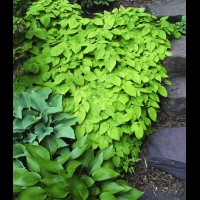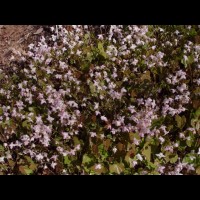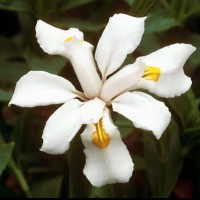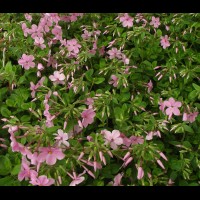Epimedium alpinum
Epimedium alpinum (Cc. 920002)
This drought tolerant spreading species from southern Europe sports very small flowers held below and among medium-sized leaflets. Inner-sepals are red behind creamy-yellow petals/spurs. 12" tall. The leaflets flaunt a complementary thin, mascara-like red edge while the plant is in bloom. Spreads 8-12" a year, forming an open groundcover. Semi-evergreen.
Epimedium alpinum 'Shrimp Girl'
E. alpinum ‘Shrimp Girl’ (Cc. 930006)
The clone ‘Shrimp Girl’ is shorter in height (6-8”) than E. alpinum with shorter rhizomes; spreading only 4-5” a year. Its dense growth habit and thick foliage make it far superior at crowding out weeds. Tiny blooms appear below the leaves and are not usually noticeable unless the plant is elevated on a hillside. A short, neat, ground-covering Epimedium with a "cool" name. Semi-evergreen.
Epimedium grandiflorum 'Spring Wedding'
E. grandiflorum ‘Spring Wedding’ (Cc. 950237)
2003 Cobblewood Introduction
The fresh spring foliage of this selection emerges dark purple, then lightens and expands to display a bold, 1/4” wide, mahogany-red edge. Very floriferous, it produces numerous flower stems held well above the foliage. The medium-sized flowers have soft lavender sepals backing white petals with downward curving spurs. A plant handsome in both flower and foliage. 10” tall in bloom. Semi-evergreen leaflets hold well into autumn when they turn a limey shade of green. It tolerates alkaline soils better than most E. grandiflorums.
Epimedium grandiflorum var. violaceum 'Bronze Maiden'
E. grandiflorum var. violaceum ‘Bronze Maiden’ (Cc. 920016)
***1999 Cobblewood Introduction***
Spring leaflets emerge a glossy mahogany-red, resembling molten chocolate. This intense color complements the medium-sized lavender flowers. 8” in bloom, with a second growth flush to 12”. One of the earliest epimediums to bloom. Semi-evergreen.
Epimedium pauciflorum
E. pauciflorum (Cc. 000480)
Native to the parched regions of western Sichuan Province in China, this species is drought-tolerant. The attractive, small, rounded, spiny-edged semi-evergreen leaflets sometimes exhibit splashes of reddish-brown in spring. Produces 2 to 4 medium-sized, flowers of the palest lavender-pink on sporadic flower stems, hence the species name pauci=few florum=flowers. Spreads by thin 8 to 12" rhizomes. Best used as a very low (4-6") groundcover.
Epimedium pubigerum Cc. 920029
E. pubigerum (Cc. 920029)
Attractive small, round, heart-shaped leaflets with a matte surface, a wavy edge and a bronze overlay in spring, form on stems 8 to 10" tall. Full sprays of very small, pink-flushed, creamy-white flowers hover well above the leaves at 16-20". Early bloomer that initially stays in a clump, but with age, throws short 1-3" rhizomes, with occasional longer ones. Semi-evergreen.
Epimedium pubigerum Cc. 950215
Epimedium pubigerum (Cc. 950215)
This clone bears creamy-white flowers-- almost like tiny molars, creating a baby's breath effect-- held high above especially rounded, glossy dark green leaflets. Foliage 8-10" tall with flowers stems held at 16-20" tall. Drought tolerant. Semi-evergreen.
Epimedium pubigerum Cc. 000996
E. pubigerum (Cc. 000996)
A unique running version of this normally clump-forming and especially drought tolerant species. Handsome corrugate bright green medium-sized leaflets form an attractive, open ground cover. Abundant flower sprays reminiscent of baby's breath cover the foliage extending to 16". Each small flower has cupped white sepals that sport a smear of rose color along their lengthwise edge. A slow spreader with 2-4" rhizomes. Foliage reaches 8". Semi-evergreen.
Epimedium sempervirens "Variegated #1"
Epimedium sempervirens “Variegated #1” (Cc. 970190)
From Japan came rumors of a most spectacularly variegated Epimedium heavily dappled with white and pink and costing a small fortune. During Darrell's 1997 trip to Japan with Dan Hinkley he searched specifically for this fabled plant. Once he saw it he just had to have it—the most expensive Epimedium he's ever purchased! It was indeed the nicest variegated Epimedium he'd ever seen...and just as they said, the spring foliage is a swirling collage of creamy white, salmon-pink and apple green. What they didn’t mention was that the white portion of the variegation lasts well into the season.. into August here, before turning mostly green.
White flowers are produced above the semi-evergreen leaves. One of the shorter Epimediums at only 8” tall.
Epimedium sempervirens 'Aurora'
E. sempervirens ‘Aurora’ (Cc. 920018)
Dwarf form with large, dark silky, silvery lavender blooms with glossy, small/medium-sized leaflets. 6" tall in bloom with a second flush to 9". The new growth displays occasional dark flecking in spring. Second flush may have a pink blush as the photo shows. Often has good orange-red fall color when grown in bright shade or some sun. Named by Dick Weaver and sold by We Du as a cultivar of E. grandiflorum. Semi-evergreen.
Epimedium sempervirens 'Candy Hearts'
Epimedium sempervirens ‘Candy Hearts’ (Cc. 920038)
***2001 Cobblewood Introduction***
Exquisite spring foliage emerges an opalescent rosy-pink tone that slowly recedes over a month’s time to a rose border, before turning solid green. The showy large silvery lavender-pink flowers have wide inner-sepals and look like iridescent pearls against the colorful spring foliage. 9” tall. Semi-evergreen with medium-sized leaflets.
Epimedium sempervirens 'Okuda's White'
Epimedium sempervirens ‘Okuda’s White’ (Cc. 950036)
Introduced from Japan by George Schenk in the 1970’s. A rare and unusual spreading form of E. sempervirens, with 2-4” long rhizomes. The large, white flowers are typical of the species. Grows to 6-8” tall. Forms a nice, short, semi-evergreen groundcover over time. An early bloomer.
Epimedium sempervirens 'Passion Hearts'
Epimedium sempervirens ‘Passion Hearts’ (Cc. 180040)
***2019 Cobblewood Introduction***
A great, new introduction from Massachusetts hybridizer Mark McDonough. Spring foliage emerges a deep chocolate brown and warms up as spring progresses, through a kaleidoscope of vibrant red tones. Eventually the color fades to the edges before greening up in a tidy mound of elongated, heart-shaped leaflets. Generous clusters of medium-sized flowers with light lavender sepals and a lighter cup dot the low mound of colorful spring foliage. Semi-evergreen.
Epimedium sempervirens 'Rose Dwarf'
E. sempervirens ‘Rose Dwarf’ (Cc. 950027)
Originally offered by George Schenk in the 1970’s and still quite rare in the trade. We thank Jerry Flintoff for our original stock. Plants 5” tall in bloom with unusually long, narrow, medium-sized leaflets, gradually tapering to a thin point and flecked with bronze in the spring. Flowers similar to those of Violet Queen’, dark violet-lavender with long inner-sepals. An early bloomer. Semi-evergreen.
Epimedium sempervirens 'Secret Arrow'
Epimedium sempervirens ‘Secret Arrow’ (Cc. 950140)
***2000 Cobblewood Introduction***
Unique, arrow-shaped leaflets distinguish this plant. Large lavender flowers face out¬ward with wide inner-sepals. Cool fall temperatures turn the leaves a beautiful salmon-egg red, with limey green streaks along the main veins
Epimedium sempervirens 'Shadow Dancer'
E. sempervirens ‘Shadow Dancer’ (Cc. 000943)
***2010 Cobblewood Introduction***
This Japanese sempervirens selection has strikingly beautiful banded foliage with a royal purple edge in spring, surrounding a interior flushed with purple. The large, violet-lavender blossoms have uniform coloring throughout. Grows to 12” in height. Semi-evergreen.
Epimedium sempervirens 'Violet Queen'
Epimedium sempervirens ‘Violet Queen’ (Cc. 950138)
A spectacular Epimedium. This clone is an exact match for the plant originally named Epimedium violaceum in 1834 which was later changed to a variety of E. grandiflorum... all through the study of dried herbarium specimens. However, this plant is semi-evergreen and nearly identical to other clones Darrell received from west central Honshu including the plant depicted in Don Elick’s book, Japonica Magnifica. Perhaps it is a species of its own. This is the parent that gifted E. x rubrum, E. x versicolor ‘Versicolor’ and ‘Cupreum’ with colorful spring foliage.
Prized for its vibrant, cherry-red new growth and large, rich violet-lavender flowers with very long inner-sepals. Small/medium leaflets have a long, tapered point. Slow to propagate. 12”
Epimedium "Asiatic Hybrid"
Epimedium “Asiatic Hybrid” (Cc. 950166)
Washfield Nursery in England sold mixed seedlings of Asian parentage under the umbrella name “Asiatic Hybrid”, where Dan Hinkley originally purchased this clone. Tall sprays of delicate, small, pale pink flowers with deeper cups bloom above medium-sized, spring leaflets of a metallic pinkish-maroon hue. Blooms reach 12-15”. Semi-evergreen, arrow-shaped leaflets to 10".
Epimedium 'Flame Thrower'
Epimedium ‘Flame Thrower’ (Cc 990619)
***2009 Cobblewood Introduction***
Cheerful cherry red and creamy yellow flowers dance above the foliage of this hybrid from Darrell Probst. The inner sepals have decorative undulations to their shape, resembling flames licking upwards from the top of the flower. This cross between deciduous and evergreen parent plants gives this hybrid both vigorous growth and deep green, spiny leaflets of good substance. Drought-tolerant.
Epimedium 'Hot Lips'
Epimedium ‘Hot Lips’ (Cc. 031434)
An E. acuminatum hybrid from Diana Reeck of the former Collector's Nursery, with multi-toned flowers of hot pink with the long spurred petals that are decidedly hotter than the broad sepals. Flower stems are tinged burgundy red. Long narrow foliage emerges a reddish pink. Given a bit of bright shade or moderate sun in the north, the plant can reach 20” high. Its bright blooms and bold semi-evergreen foliage draws your eye from quite a distance.
Epimedium 'Kaguyahime'
Epimedium ‘Kaguyahime’ (Cc. 950225)
From Japan (via Mikinori Ogisu & Robin White) comes this delicately beautiful hybrid of E. acuminatum and E. dolichostemon. 15-18” stems carry sprays of small flowers with dark reddish-purple spurs and light rose-pink inner sepals. Long, slender arrow-shaped, medium-sized leaflets are jagged edged and beautifully mottled with various shades of red in spring. Vigorous for an semi-evergreen Epimedium, it is one of my favorites, and is named after a popular Japanese folk princess.
Epimedium 'Lemon Zest'
Epimedium ‘Lemon Zest’ (Cc. 990617)
***2005 Cobblewood Introduction***
From low, dense rosettes of small, shiny, rounded semi-evergreen leaflets flushed bronze in spring, emerge many erect racemes up to 12-15” high of cheerful, bright lemon-yellow bells. A slowly spreading hybrid which throws occasional rhizomes. A hybrid created by Darrell Probst. Foliage to 6". Flowers to 12".
Epimedium 'Lilac Cascade'
Epimedium ‘Lilac Cascade’ (Cc. 950236)
***2001 Cobblewood Introduction***
In spring the new foliage emerges in beautiful shades of rose and pink. By bloom time, the leaflets turn almost solid green with a purplish-red border, forming a perfect mound of cascading foliage. Just above the leaves are clusters of rich violet-lavender flowers. Later, a second flush of vibrant hot raspberry-pink foliage emerges and remains colorful for several weeks. 6 to 8” tall in bloom with the second flush to 12-14”. From Darrell Probst's cross between E. sempervirens ‘Candy Hearts’ and E. grandiflorum ‘Yubae’. The foliage is like the former— semi-evergreen, medium-sized round hearts. Drought-tolerant.
Epimedium 'Pretty In Pink'
Epimedium ‘Pretty in Pink’ (Cc. 130001)
This 2012 Plant Delights Nursery introduction by Tony Avent is a vigorous E. grandiflorum hybrid with exceptional foliage. Small clusters of large, showy flowers with pink spurs and a raspberry cup are held just above the leaves during the mid-late Epimedium bloom season.
The new spring growth is patterned with subdued maroon flecks, eventually hardening off as handsome, glossy, medium-sized green leaflets, followed by a flush of blush pink second growth foliage. Tony describes the leaflets as "tardily deciduous"-- what I call "semi-evergreen". One of the best for thick, lustrous summer foliage. To 12".
Epimedium 'Serendipity'
Epimedium 'Serendipity' (Cc. 060300)
***2017 Cobblewood Introduction***
A chance open-pollinated seedling of E. pauciflorum brought to my attention by to Elaine Chittenden of Smith College Botanic Garden, this selection is an excellent white-flowered, spreading Epimedium-- a rare find. Low and vigorous with loads of cheerful, white flowers (touched with light lavender, but they “read” as white) are scattered 8 to 10” above small, chocolate-edged and irregularly speckled leaflets-- quite unlike any E. pauciflorum I know. Similar to E. grandiflorum var. higoense in size and shape, but it spreads with 1-4” long rhizomes. Initially forms a 4-6” high, dense groundcover, perfect for small gardens or small spaces. Sparse second growth flush to 12". Semi-evergreen. Now how is that for a happy chance!
Epimedium 'Short Story'
Epimedium ‘Short Story’ (Cc. 170040)
***2019 Cobblewood Introduction***
A showy, robust, new hybrid from Massachusetts breeder Mark McDonough. This unique selection combines the best of evergreen E. brachyrrhizum and deciduous E. grandiflorum. Spring emergence starts with an upright filigree of bronze stems and small leaflets, giving high visibility to luscious clusters of large silvery pink flowers with conspicuously down-turned spurs. As the leaves expand they are mottled in soft red. The flowers are held high and more prominently than in brachyrrhizum, for a fine display. The second flush of semi-evergreen foliage is just as dramatic as the plant is in bloom, boldly marked with bright red over chartreuse green.
Epimedium 'Splish Splash'
Epimedium 'Splish Splash' (Cc. 150001)
This beauty is a 2013 Plant Delights Nursery introduction that is certainly worth of a place in the garden. The arrow-shaped spring leaflets are heavily mottled in rich mahogany during the cool spring weather. The dark green mottled foliage serves as a great background to show off the multitudes of clean white flowers. Up to 12" in bloom. Semi-evergreen.
Epimedium 'William Stearn'
Epimedium 'William Stearn' (Cc. 150004)
A hybrid from Robin White of the former Blackthorn Nursery in Hampshire, England. As one of the earliest "red" flowering epimediums, it was named for the late William Stearn who wrote the monograph on Epimediums in 1938 (revised in 2002 by Timber Press).
The arrow-shaped, semi-evergreen leaflets form a handsome clump, exhibiting reddish-brown mottling in the spring. Produces short, few-flowered stems of muddy red and yellow flowers. I have found it to be slow to establish in the garden. The foliage is its greatest asset, in my opinion.
Epimedium 'Windfire'
Epimedium ‘Windfire’ (Cc. 002114)
**2007 Cobblewood Introduction***
Wiry, black-red upright flower spikes rise above the foliage carrying large, canary yellow flowers with small, dark red sepals. The thin reflexed spurs give the flower a very elegant silhouette. Slightly spreading with an open habit, by rhizomes that grow 4” a year. Medium-sized semi-evergreen leaflets form a leafy, open base to 12”. Flower spikes to 20”.
Epimedium 'Yokihi'
Epimedium ‘Yokihi’ (Cc. 050030)
An outstanding late-blooming Japanese cross between E. davidii and E. grandiflorum ‘Yubae’, this clumping hybrid produces long arching 18” spikes of large spidery flowers. The dramatic flowers have a flared creamy yellow cup and long, slender spurs backed by short, bright reddish pink inner sepals. Medium green angular leaflets are flushed with bronzy red in spring. Semi-evergreen.
E x cantabrigiense "Red Form"
E. ×cantabrigiense “Red Form” (Cc. 950018)
A tough, slightly-spreading natural hybrid of E. alpinum, which the deeply veined leaves most closely resemble, and E. pubigerum, which the floral sprays most resemble. One of many plants for which we are grateful to Jerry Flintoff, as Darrell has not found it elsewhere in the U.S. This clone was very common in many of the British gardens we visited in April 1998. The sepals are dark red rather than the pale salmon of the clone commonly cultivated in the U.S. Numeroua, small flowers bloom well above the leaves on loosely branched 18” stems. More vigorous than the U.S. form, with larger, medium-sized leaflets. Semi-evergreen.
Epimedium x rubrum 'Sweetheart'
Epimedium x rubrum ‘Sweetheart’ (Cc. 930007)
***1997 Cobblewood Introduction***
This cultivar easily rivals Hosta as a bold textural garden accent. The first of Darrell Probst's Epimedium introductions, resulting from a 1991 cross he made between E. sempervirens ‘Candy Hearts’ and E. alpinum. Flowers with dark rose-red sepals bloom above and below the leaves. Leaflets are much larger, darker green and more rounded than is typical. Large, shiny new leaflets bear a thin red rim in spring. Semi-evergreen. 16" tall. Foliage is far superior to E. x rubrum, and the plant is much more drought-tolerant. Spreads by 2-4" rhizomes.
Epimedium x sasakii Cc 950137
Epimedium x sasakii (Cc. 950137)
In Japan, wherever the habitats of E. sempervirens and E. x setosum overlap, hybrids occur. These highly variable hybrids were given the name E. x sasakii by Japanese botanists. However, the name is still little recognized by western botanists. All of the clones we've grown so far are semi-evergreen. 6” tall in bloom, second flush to 16”. Small, charming dark grayish-lavender flowers. In spring the leaflets are defined by a dark, thin, mascara-like maroon line at the edge of the leaf. Fall color changes to a taupe or sometimes scarlet with green veining.
Epimedium x setosum Cc. 950163
E. x setosum (Cc. 950163)
This is the typical form of this naturally occurring fertile hybrid collected in northern Kyushu, Japan. It is larger overall than others in commerce, growing up to 12” tall, with larger leaflets. Small white flowers are produced in sprays above the leaves that may appear bronzed in spring/fall. Semi-evergreen.
E x setosum Cc 960059
E. x setosum (Cc. 960059)
A very floriferous clone from the garden of Harold Epstein. Medium-sized leaflets with prominently spined margins on plants literally covered with numerous sprays of white flowers. 8-10” tall. Semi-evergreen foliage sports a reddish fall color. A favorite of the clones we grow, but each possesses individual charm.
Epimedium x versicolor 'Cherry Tart'
Epimedium x versicolor ‘Cherry Tart’ (Cc. 970064)
***1999 Cobblewood Introduction***
A spontaneous seedling originating in the garden of Judy Springer, formerly of Great Falls, VA. Erect stems sport numerous, outfacing flowers. Large, medium-pink inner sepals back flaming, cherry-red spurs with a bright, lemon-rimmed cup. Spreads slowly by 2-4” long rhizomes. Medium-sized leaflets are handsomely flushed with reddish-purple in spring with a mustard tone that changes to a dark burgundy blush in the fall. 12-15”. Blooms early and is drought-tolerant. Semi-evergreen.
Epimedium x versicolor 'Neosulphureum'
E. x versicolor ‘Neosulphureum’ (Cc. 920044)
Undeservedly rare in cultivation, this counterpart to the more common ‘Sulphureum’ is shorter and semi-spreading with 2-4” rhizomes that form a tight groundcover. Pale yellow flowers are held on 12” erect, airy sprays. Flower spurs half as long as the inner-sepals. Spring leaflets are nicely bronzed on stems 6-8” and form a darker background against which to view the soft yellow flowers. Early bloomer and drought-tolerant. Semi-evergreen.
Epimedium x versicolor 'Strawberry Blush'
E. x versicolor ‘Strawberry Blush’ (Cc. 990615)
***2004 Cobblewood Introduction***
Wide, antique pink sepals brushed with rose streaks back a cheerful lemon-yellow cup, which deepens to rose purple short, curved spurs. The soft pastel flowers blend beautifully with the pinkish maroon mottled new spring leaflets. Darkest at the edges, the color fades to green at the center of small/medium-sized leaflets, before turning entirely green. Handsome, medium green, glossy summer/fall foliage. Particularly drought tolerant. Semi-evergreen. Flowers/foliage to 10”. Spreading rhizomes grow 2-4" per year. Drought-tolerant.
Epimedium xversicolor 'Sulphureum'
Epimedium xversicolor ‘Sulphureum’ (Cc. 840002)
(Synonym: E. pallidum)
Superb in mass plantings, it spreads 4-5” a year, forming a thick groundcover of leaves that holds its own against weeds. Bears long sprays of pale yellow flowers with spurs nearly equal in length to the inner-sepals are produced above leaflets flushed red in spring. 10" tall in bloom. Semi-evergreen leaves. Drought-tolerant.
Epimedium x versicolor 'Versicolor'
E. versicolor x ‘Versicolor’ (Cc. 890006)
(syn. E. x versicolor 'Discolor')
Quite rare in gardens, this has long been one of our favorite clones. Delicate flowers open a deep, rich pink-salmon, and fade over the course of several days. Large panicles of flowers hover above leaflets strongly flushed with red in spring. It spreads 4 to 5" a year forming a gorgeous mass of riotous color in spring. 14" tall. Early bloomer and drought-tolerant. Very similar to E. x versicolor 'Cupreum' in appearance and habit. Semi-evergreen.
E x youngianum 'Fairy Dust'
E. x youngianum ‘Fairy Dust’ (Cc. 950241)
***2004 Cobblewood Introduction***
Small, simple, lavender-pink flowers with small white spurs lift their faces above the foliage in spring. The color deepens toward the edge of each flower part. Fresh spring leaves have the texture of silk and are tinted in a delicate shade of mocha. Compact growth at 7” in bloom, and flowers to 10”, creating a neat and tidy effect. Early bloomer. Semi-evergreen.
Epimedium x youngianum ‘Grape Fizz’
E. x youngianum ‘Grape Fizz’ (Cc. 950242)
***2004 Cobblewood Introduction***
Small, rich, grape-purple buds open to release full, blue-lavender blossoms with irregular white highlights at the base of each part. Each flower has four vestigial white spurs. Flowers form a loose tumble above a low 5” mound of lime-green foliage. 7” in bloom. Long lasting bloom. New foliage has a brownish tint. The medium-sized leaves have acute basal lobes and deeply indented veins, producing a seer
Epimedium x youngianum 'Little Shield'
Epimedium x youngianum ‘Little Shield’ (Cc. 950240)
***2004 Cobblewood Introduction***
Distinctive shield-shaped leaves are part of this plant’s allure. In spring a soft overlay of milky mocha covers the small to medium-sized leaves, heavily indented at the veins. 8” tall in bloom, with numerous, perky 3/4” white flowers held above the foliage. Spurs slightly longer than sepals. Semi-evergreen.
Epimedium x youngianum 'Milk Chocolate'
Epimedium x youngianum ‘Milk Chocolate’ (Cc. 990616)
***2005 Cobblewood Introduction***
‘Milky Way’ sometimes produces sporadic new spring leaflets that are nearly solid purple. Darrell once found an entirely purple leaf, selected that division, and began propagating it to stabilize the characteristic. The resulting ‘Milk Chocolate’ produces small chocolate-purple leaves with tiny green flecks in spring. The color remains for weeks in contrast with the multitudes of white, medium-sized flowers. Semi-evergreen. 6” in bloom, to 12”.
Epimedium x youngianum 'Milky Way'
E. x youngianum ‘Milky Way’ (Cc. 920046)
This Dick Weaver introduction has pristine, medium-sized white flowers with long spurs. The new spring foliage is attractively speckled with a multitude of deep purple markings. At maturity, the small semi-evergreen leaflets display an attractive persistent silver overlay on the main veins. 6" in bloom. Second growth to 12".
Epimedium x youngianum 'Royal Flush'
E. x youngianum ‘Royal Flush’ (Cc. 950239)
***2004 Cobblewood Introduction***
New leaflets emerge a rich chestnut, changing to a bright bur
Epimedium x youngianum 'White Star'
Epimedium x youngianum ‘White Star’ (Cc. 950011)
***2000 Cobblewood Introduction***
A spontaneous open pollinated seedling found in the Asian Collections at the U.S. National Arboretum. This floriferous clone bears small, white flowers with spurs equal in length to the inner-sepals. The small thick leaflets remain evergreen in USDA Zone 7 and farther south, semi-evergreen elsewhere. Delightful at 5" tall in bloom, eventually growing to 8". Its exceptional foliage makes it a nice edging plant.
Iris koreana 'Firefly Shuffle'
Iris koreana ‘Firefly Shuffle’
***2010 Cobblewood Introduction***
A very floriferous clone of this Asian species iris, and a good grower. Mid May is heralded with the annual explosion of sunny, bright lemon yellow blossoms covering the plant. Great for the rock garden. Best in bright shade or a few hours of direct sun, it forms a grassy-leaved clump that slowly spreads into a “patch”. Semi-evergreen.
Iris odaesanensis
Iris odaesanensis
Pristine white flowers with a yellow signal edged in a thin, brown halo. Two flowers, each nearly 2” in diameter, are borne atop 8” stems in late May. Semi-evergreen leaves expand after bloom to reach 12” long, 1/2” wide, forming dense clumps of arching foliage. Prefers a little more sun than Epimediums. This clone was originally collected on Odaesan in Korea by Darrell Probst in 1997.
Iris odaesanensis Chuwangsan #3
Iris odaesanensis “Chuwangsan #3”
I. odaesanensis was previously known to exist only on the top of Odae-san (san = mountain). To the surprise of his Korean host from Chollipo Arboretum, Darrell found a few pockets of it growing on a wooded rocky ledge on Chuwangsan, 100 miles south of Odaesan. He collected three unique clones.
The flowers of this vigorous grower lack the typical brown halo surrounding the signal. It also seems to be less tasty to the local slugs. Semi-evergreen.
Iris odaesanensis 'Ice Whisper'
An icy-blue lavender-flowered variant of this normally white-flowered species. Darrell collected a pale lavender-flowered clone in Korea, and grew seed from that plant. This is his deepest lavender-flowered selection.
Semi-evergreen leaves grow to 12" after bloom, forming dense clumps of arching foliage. Half to full sun exposure.
Phlox stolonifera 'Wister Pink'
Phlox stolonifera 'Wister Pink'
A dusky pink form of this easy to grow native plant, not commonly available in the trade. The rounded leaves form a thick groundcover 2-3" high, above which the large flowers bloom in mid-May in Massachusetts. 6-8" tall in bloom. Spreads by 6-8" runners. Semi-evergreen.
Primula kisoana forma alba
Primula kisoana f. alba
The white-flowered form of this spreading Japanese woodland primrose. Downy, scalloped light green foliage is very different from other Primulas. Great as a low ground cover planted at the base taller woodland plants. Clusters of white flowers in mid-May. Prefers evenly moist, humus-rich soils. 4-6” high. Spreads by rhizomes of varying length to form extensive, thick colonies over time.
Trillium pusillum 'Roadrunner'
Trillium pusillum ‘Roadrunner’
***2007 Joe Pye Weed's Garden Introduction***
Trilliums are notoriously slow to propagate. While this diminuitive species propagates faster than most, this clone grows particularly rapidly, making a substantial, floriferous clump in just a few years. Trillium pusillum is native to S.E. United States west to Oklahoma. New spring leaves emerge dark purple, almost black, and remain so as the 1-1/2” white, tri-petaled flowers open. It begins bloom at 4", with the foliage eventually reaching 12" tall. Foliage usually goes dormant and disappears by summer's end. Each petal has a rosy reverse. Foliage matures to green as the flowers blush to pink as they age.









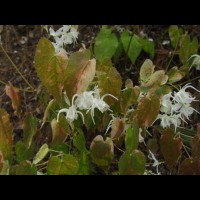










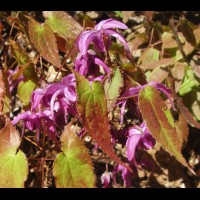






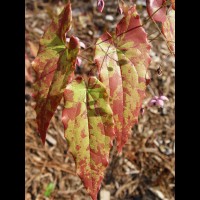





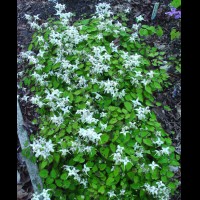



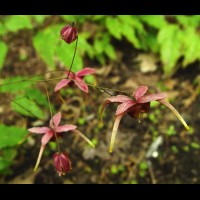


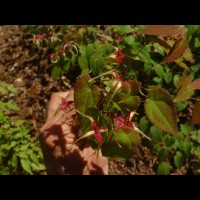

.jpg)
.jpg)
